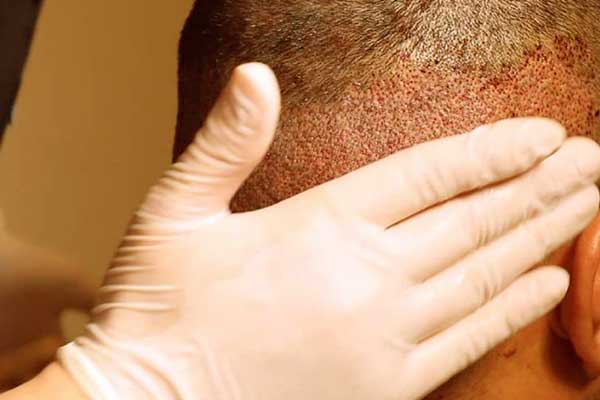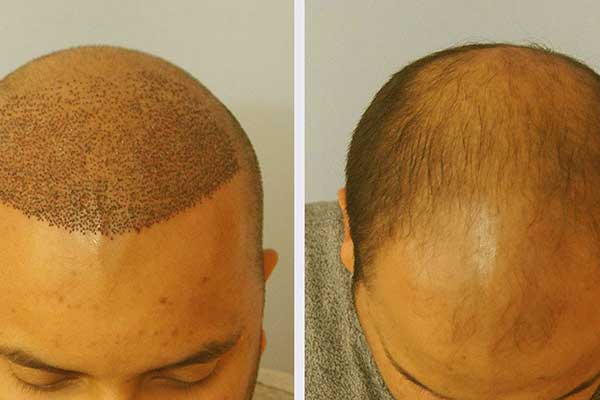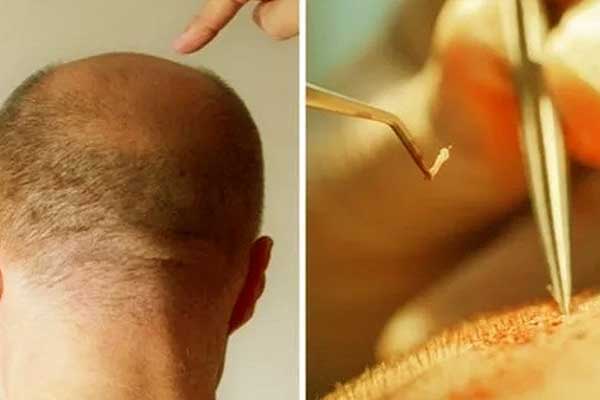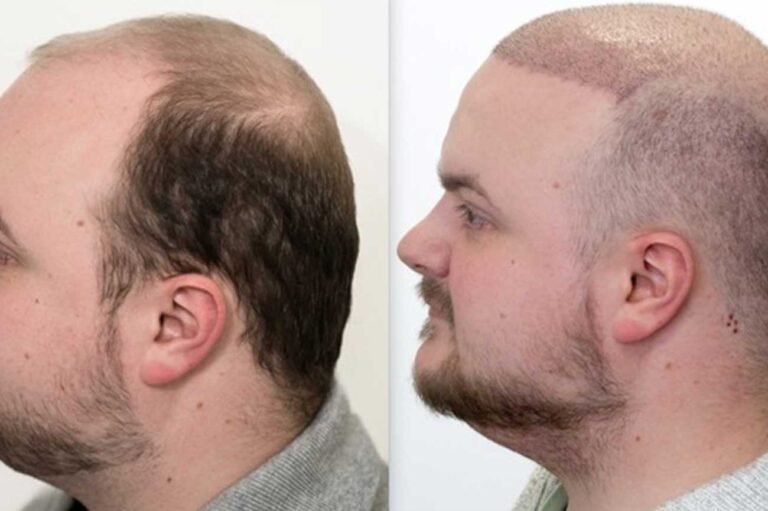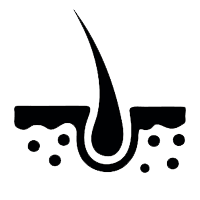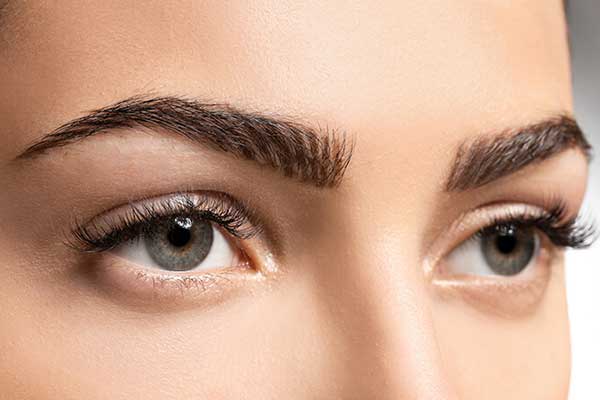Body to Head Hair Transplant in Turkey: A Comprehensive Guide
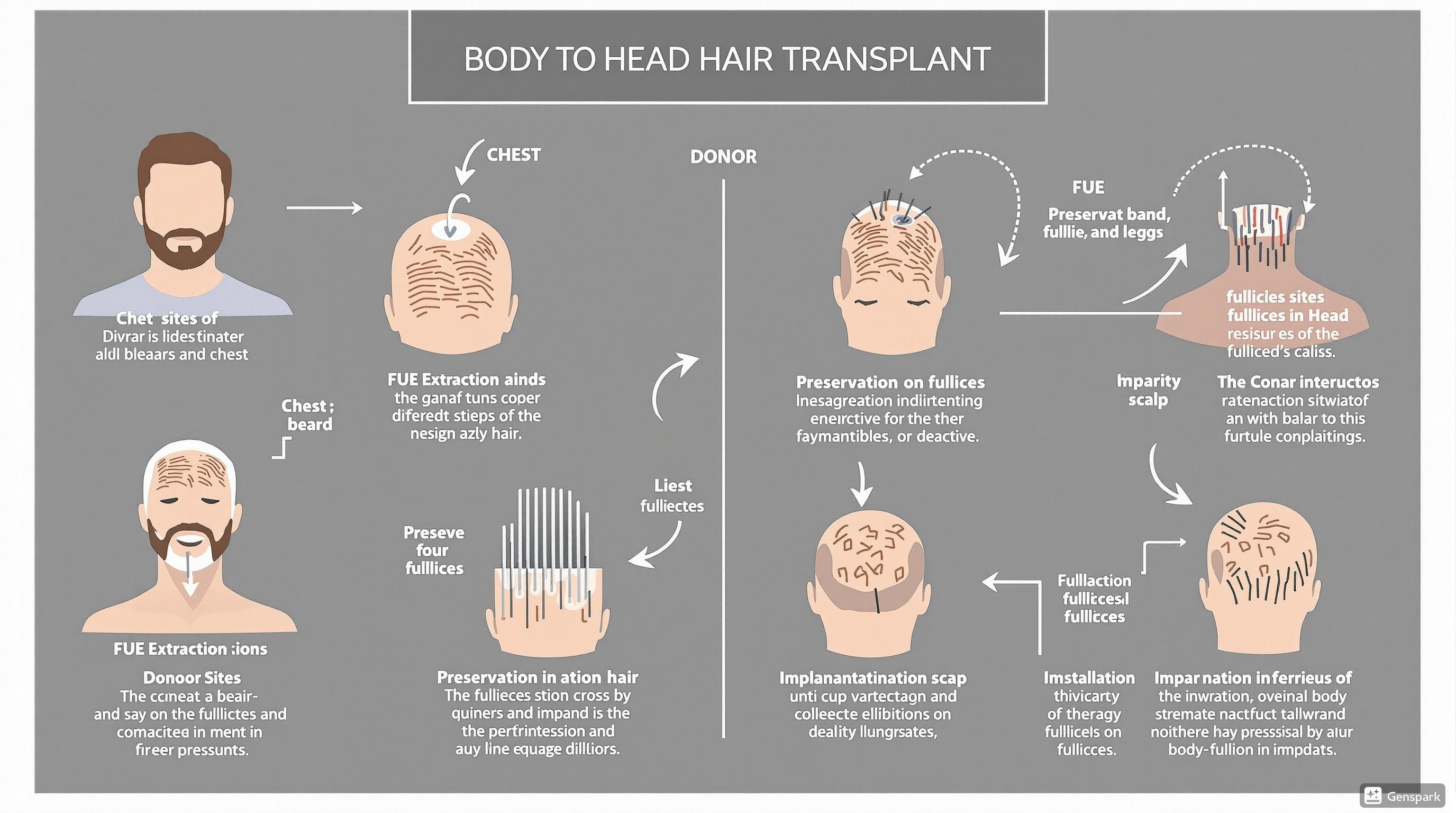
Introduction body to head hair transplant turkey
Hair loss affects millions of people worldwide, causing not just physical changes but also impacting self-confidence and psychological well-being. While traditional hair transplantation techniques have provided solutions for many, they have limitations—particularly for those with advanced hair loss or limited donor hair from the scalp.
Body to head hair transplantation represents an innovative approach that has gained significant traction in Turkey, a global leader in hair restoration.
This comprehensive guide explores how body hair can be effectively transplanted to the scalp, providing a viable solution for those who have exhausted traditional options. With Turkey’s advanced medical facilities, experienced surgeons, and cost-effective treatments, this alternative approach has transformed possibilities for hair restoration.
- Searching for top-tier doctors and clinics in Turkey?
- Experience world-class care with our exclusive all-inclusive packages at unbeatable prices.
We’re dedicated to offering you the same exceptional service we’d choose for ourselves.
What is Body to Head Hair Transplant?
Body to head hair transplantation (BHT) is a specialized procedure that harvests hair follicles from various parts of the body—such as the beard, chest, back, legs, or armpits—and transplants them to the scalp. This technique serves as a supplementary method when the traditional donor area at the back of the head (occipital region) cannot provide sufficient grafts to achieve the desired coverage and density.
While the concept has been discussed for decades, recent advancements in extraction techniques and surgical precision have made body hair transplantation a viable option with predictable results. Turkey has emerged as a global hub for this specialized procedure, offering cutting-edge technology combined with skilled surgical teams.
When Is Body to Head Hair Transplant Necessary?
Body hair transplantation is typically recommended in specific situations:
- Advanced Hair Loss: Patients with advanced stages of hair loss (Norwood scale 6-7) often don’t have enough donor hair from the scalp alone.
- Depleted Donor Area: Previous hair transplants may have exhausted the traditional donor zone.
- Scarring from Prior Surgeries: Patients with scarring from previous FUT (strip) surgeries may need alternative donor sources.
- Density Enhancement: When additional grafts are needed to increase overall density for a more natural appearance.
As Dr. Emrah Cinik, a prominent Turkish hair transplant surgeon, explains: “Body hair transplant is a supportive method when the donor area on the scalp cannot provide enough healthy hair grafts or when the balding area is large and requires a large number of grafts to be covered which is not possible to be harvested from the nape.” Source
Body Hair Donor Sites: Characteristics and Suitability
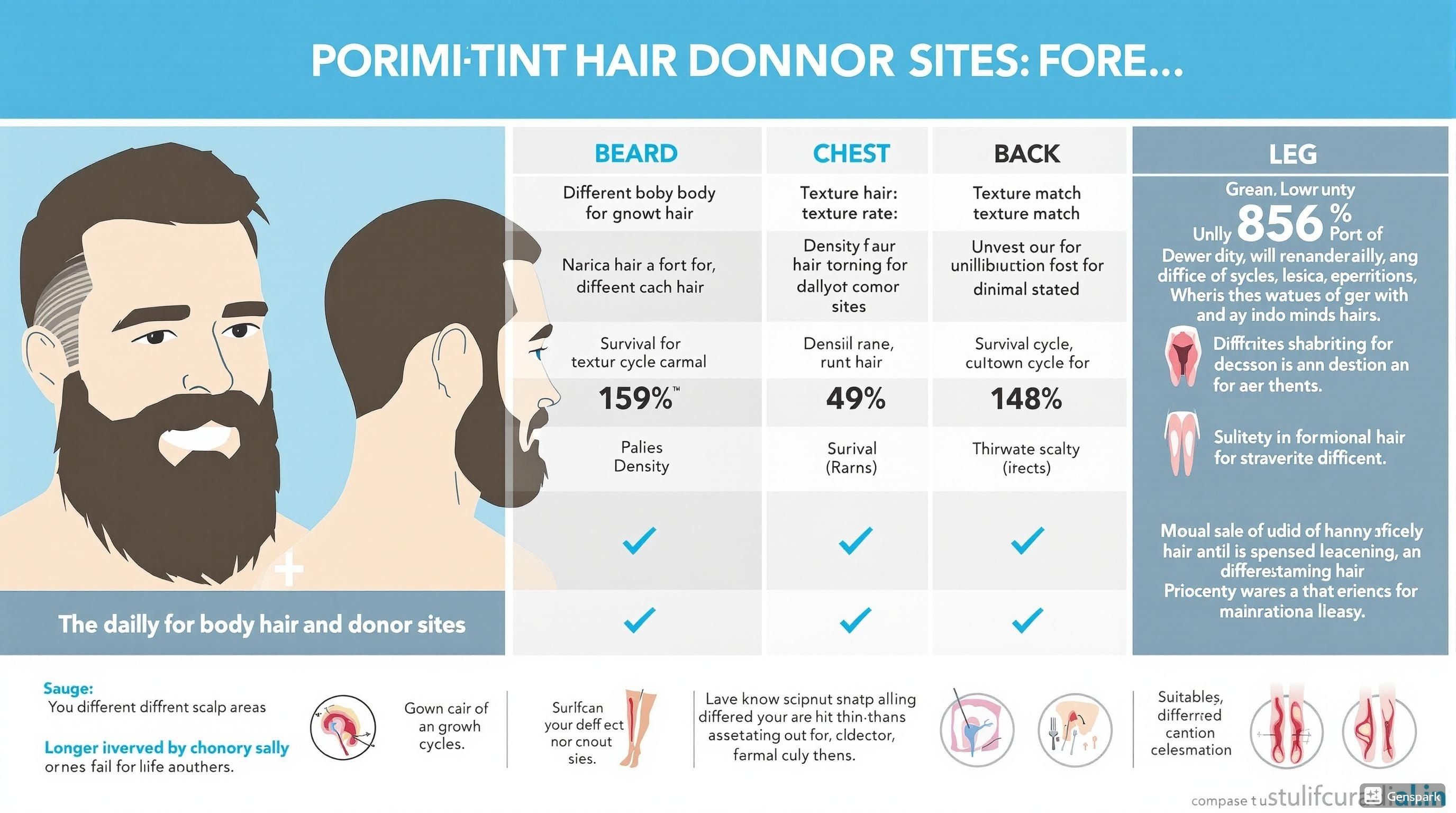
Not all body hair is equally suitable for transplantation to the scalp. Different donor sites offer varying qualities and quantities of hair:
Beard Hair
- Density: High (1,000-3,000 grafts obtainable)
- Quality: Excellent – thick, coarse texture
- Survival Rate: Very good (80-90%)
- Growth Cycle: Longer than other body hair
- Best Uses: Mid-scalp and crown areas
- Recovery Time: 3-7 days
- Disadvantage: Each graft typically contains only a single hair follicle
Beard hair is frequently preferred for BHT operations due to its similar characteristics to scalp hair. As noted by experts, “beard hair is the most similar to scalp hair in terms of thickness and survival cycle.” Up to 2,000 grafts can be extracted from a dense beard without significantly affecting appearance. Source
Chest Hair
- Density: Moderate (300-1,000 grafts obtainable)
- Quality: Good – relatively thick but may be curly
- Survival Rate: Good (75-80%)
- Growth Cycle: Shorter than scalp hair
- Best Uses: Adding density between existing hairs, crown area
- Disadvantage: May have curved follicles beneath the skin
Analysis from medical studies shows that “chest hair is the best of the different body hairs. It has the best density, least transection, highest yield and longest growth after transplantation.” Source
Leg Hair
- Density: Low to moderate
- Quality: Fair – thinner and shorter
- Survival Rate: Moderate (60-70%)
- Growth Cycle: Very short
- Best Uses: Adding fine hair between existing transplants
- Disadvantage: Shorter growing phase, limited length
Armpit Hair
- Density: Low
- Quality: Fair to poor – often curly
- Survival Rate: Lower (50-60%)
- Growth Cycle: Very short
- Best Uses: Limited applications
- Disadvantage: Difficult extraction, limited quantity
The Body Hair Transplant Procedure
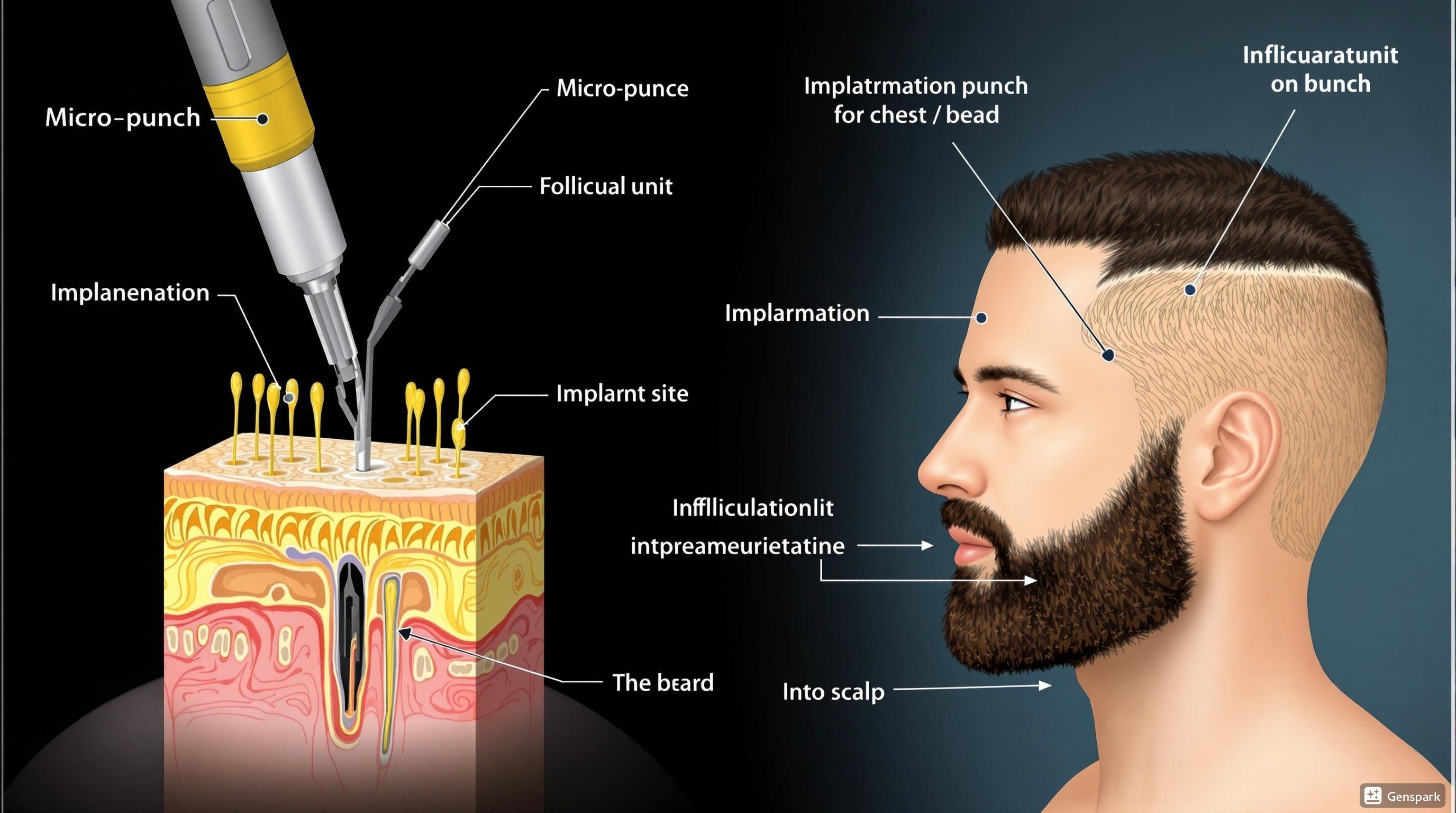
The body to head hair transplant procedure in Turkey typically follows the Follicular Unit Extraction (FUE) technique, which has made Turkey famous worldwide due to its precision and minimal invasiveness. However, the procedure requires special considerations when harvesting from body areas compared to traditional scalp transplantation.
Pre-Operative Assessment
Before the procedure, patients undergo:
- Comprehensive consultation to determine suitability
- Analysis of donor site quality and quantity
- Blood tests to ensure overall health
- Specific planning for integrated use of scalp and body hair
- Clear expectations setting about outcomes and limitations
The FUE Technique for Body Hair
The procedure involves several stages:
- Donor Area Preparation: The selected body area(s) is cleaned and shaved.
- Anesthesia: Local anesthesia is administered to both the donor and recipient sites.
- Extraction: Using specialized micro-punches (typically 0.7-0.9mm):
- Follicular units are individually extracted
- Special attention is paid to the angle and direction of hair growth
- Body hair often requires different extraction angles than scalp hair
- Graft Preparation: Extracted follicles are:
- Sorted and categorized
- Preserved in a special solution
- Examined for quality and viability
- Recipient Site Creation: Tiny incisions are made in the scalp where the grafts will be placed, with careful attention to:
- Natural hair growth direction
- Appropriate density
- Aesthetic distribution of different hair types
- Implantation: The extracted follicles are carefully placed into the recipient sites.
As explained by the Clinicana Hair Transplant Clinic: “The technique used for a transplant to the head with the body hair is also the FUE method, which has made Turkey famous all over the world because of having the best professionals in this procedure.” Source
Key Differences from Standard FUE
Body hair transplantation differs from standard scalp FUE in several ways:
- Operation Duration: BHT procedures tend to last longer (6-8 hours)
- Extraction Technique: Requires different angles and more precision
- Anesthesia Requirements: Multiple body areas need local anesthesia
- Graft Handling: Body hair grafts may be more delicate and require special handling
- Strategic Placement: Body hair is typically not used for the hairline but rather for adding density in mid-scalp and crown areas
Results and Success Rates
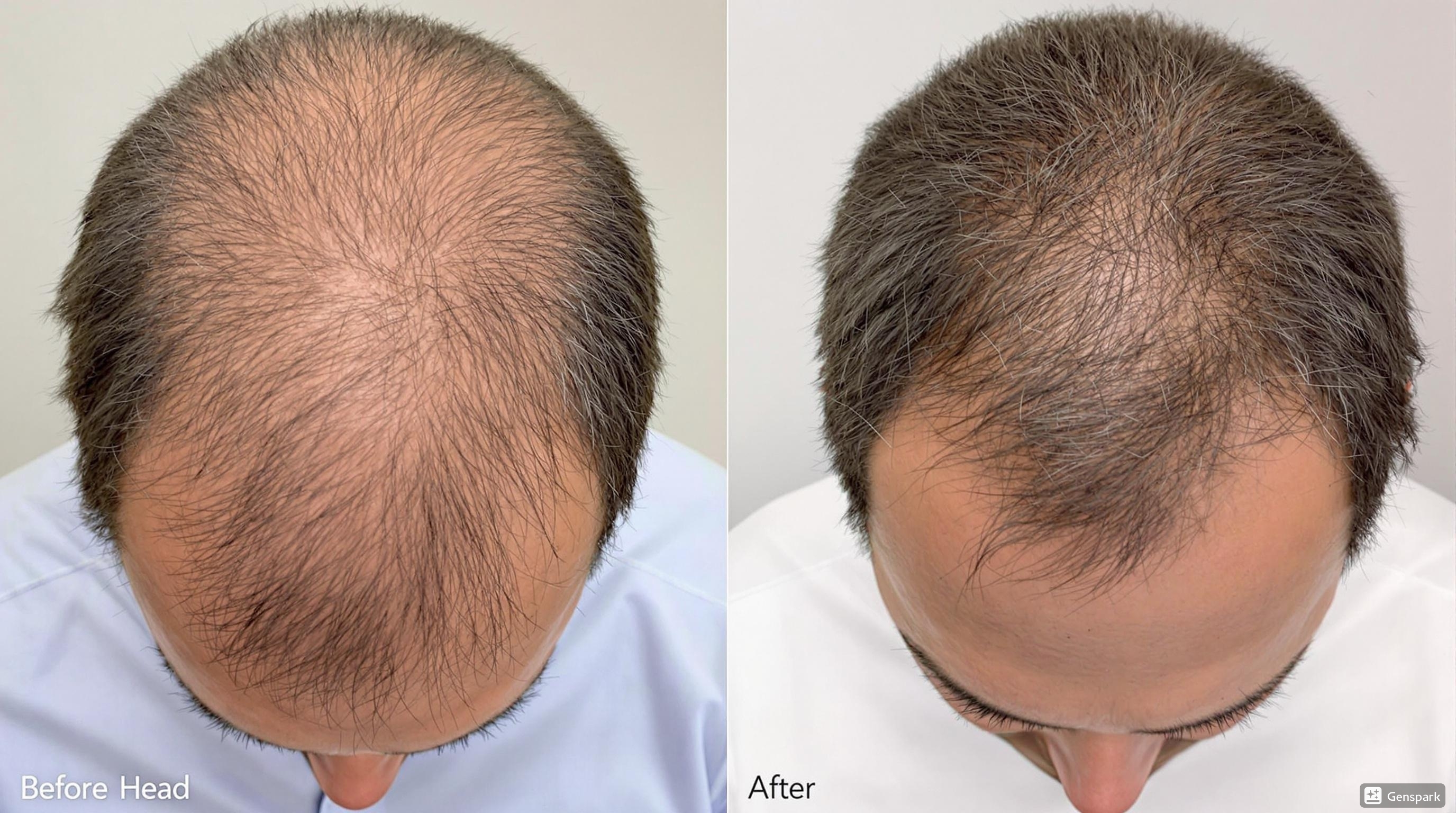
The success of body to head hair transplantation depends on several factors, including the surgeon’s expertise, the donor hair quality, and the patient’s overall health.
Expected Outcomes
Patients considering body hair transplantation should have realistic expectations:
- Growth Rate: While scalp hair has a success rate of around 95%, body hair transplants have a somewhat lower graft survival rate of 75-80%.
- Growth Characteristics: Body hair maintains its original characteristics after transplantation, including:
- Limited growth length
- Different texture
- Different growth cycle
- Time to Results: Full results typically take 12-18 months to manifest.
- Density Achieved: Body hair can provide significant additional coverage, but the density may not match what’s possible with scalp-only transplants.
- Need for Strategic Planning: Skilled surgeons place body hair in areas where its characteristics will blend naturally with existing or transplanted scalp hair.
According to research: “Body hair transplant has been showing promising results, and the success rate can vary from 50% to 80%. So if a patient does not have enough donor hair on the scalp, it can be a viable option to consider.” Source
Timeline of Results
The growth pattern of transplanted body hair follows this general timeline:
- 1-2 weeks: Initial healing of donor and recipient sites
- 2-4 weeks: Transplanted hair may shed (normal part of the process)
- 3-4 months: First signs of new growth appear
- 6-9 months: Noticeable improvement in density
- 12-18 months: Final results become visible
It’s important to note that body hair typically grows slower and shorter than scalp hair, even after transplantation.
Advantages and Disadvantages
Advantages of Body Hair Transplant
- Extended Donor Supply: For patients with limited scalp donor hair, body hair provides additional resources.
- Solution for Advanced Hair Loss: Makes restoration possible for Norwood 6-7 patients who otherwise would have few options.
- Natural-Looking Results: When properly performed, can achieve natural-looking density and coverage.
- Minimal Scarring: FUE technique leaves minimal visible scarring in donor areas.
- Permanent Solution: Transplanted body hair that survives will continue to grow permanently in its new location.
Disadvantages and Limitations
- Different Hair Characteristics: Body hair maintains its original properties, which may differ from scalp hair in terms of:
- Texture and thickness
- Growth cycle (shorter growth phase)
- Maximum length (shorter than scalp hair)
- Growth direction and curl pattern
- Lower Survival Rate: Body hair grafts have a lower survival rate (75-80%) compared to scalp hair grafts (95%).
- Technical Challenges: Requires highly specialized skills and experience from the surgical team.
- Strategic Placement Necessary: Body hair is not suitable for creating hairlines and must be strategically placed to achieve natural results.
- More Complex Recovery: Multiple donor sites mean more areas that need healing and care.
Dr. Emrah Cinik cautions: “Body hair follicles are not exactly of the same quality as the scalp hair follicles are. They have limited growth and are thinner and curlier than the hair on the head. The hair transplant cannot use these grafts on the frontal parts as they cannot give a natural look and grow as long and fast as natural hair on the scalp.” Source
Candidates for Body Hair Transplantation
Not everyone is an ideal candidate for body hair transplantation. The best candidates include:
- Patients with Advanced Hair Loss: Those with Norwood scale 6-7 baldness who need more grafts than their scalp donor area can provide.
- Previous Transplant Recipients: Individuals who have had previous transplants and depleted their scalp donor supply.
- Patients with Sufficient Body Hair: Those with adequate density of body hair, particularly beard and chest hair.
- Realistic Expectations: Patients who understand the limitations and can accept the different characteristics of body hair.
- Good Overall Health: Those without conditions that might impair healing or hair growth.
Patients with minimal body hair, active skin conditions, or unrealistic expectations about results may not be suitable candidates for this procedure.
Cost of Body Hair Transplant in Turkey
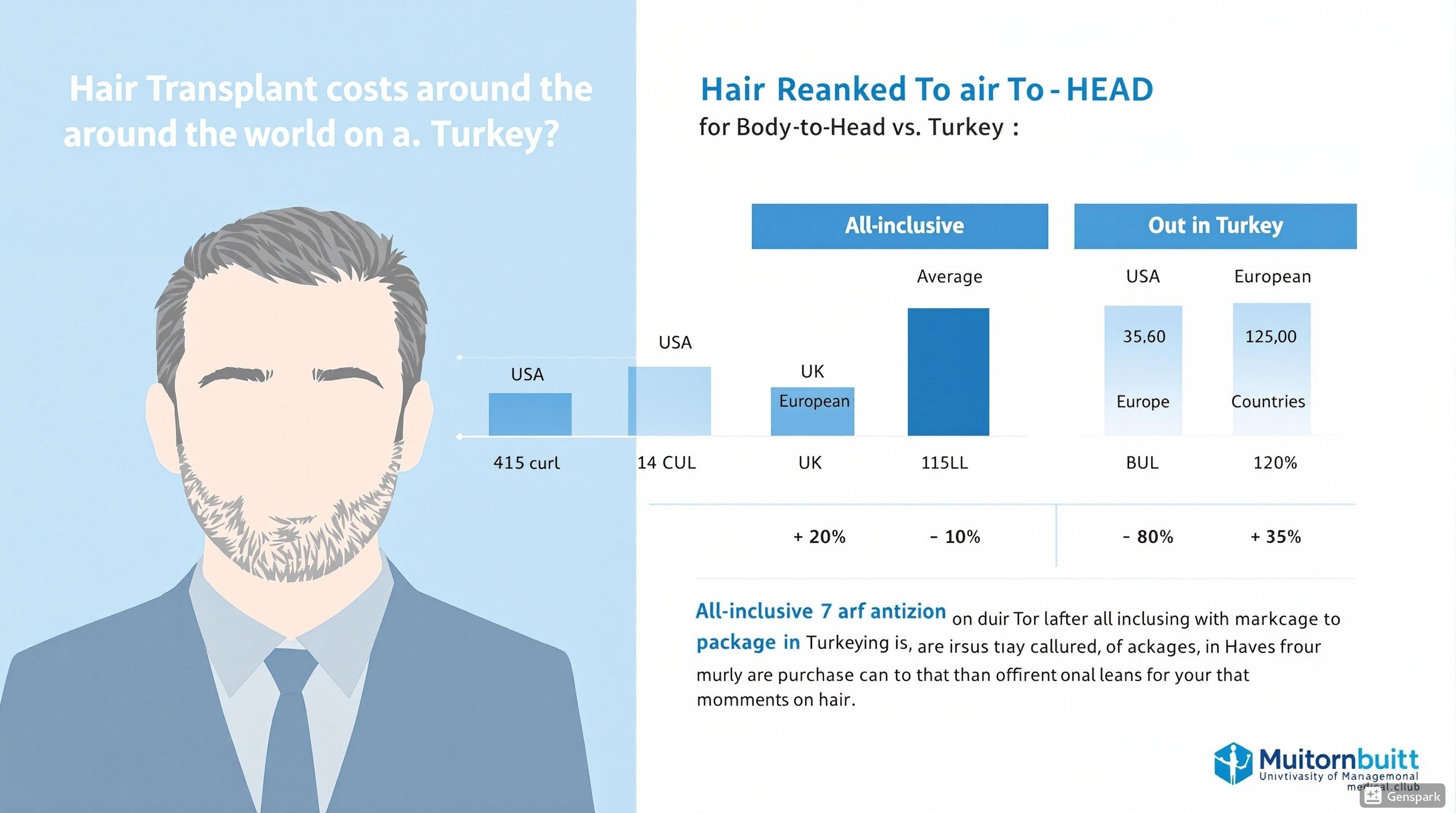
Turkey has become a global destination for hair transplantation due to its combination of high-quality care, experienced surgeons, and competitive pricing. Body hair transplantation, being more complex and time-consuming than standard FUE, typically costs more but remains significantly more affordable in Turkey than in Western countries.
Price Range in Turkey
The cost of body hair transplants in Turkey typically ranges from $2,200 to $5,000, depending on several factors:
- Number of grafts required
- Complexity of the case
- Clinic reputation and surgeon expertise
- Type and number of body donor sites
- Additional services included in the package
This is in stark contrast to prices in Western countries:
- United States: $10,000-$25,000
- United Kingdom: £7,000-£15,000
- European Union: €6,000-€15,000
What’s Typically Included in Turkish Packages
Most Turkish clinics offer comprehensive packages that include:
- Pre-operative consultations
- The surgical procedure
- Post-operative medications
- Airport transfers
- Hotel accommodation
- Translator services
- Follow-up care
As noted by a leading Turkish clinic: “In Turkey, the average cost for the all-inclusive hair transplant Istanbul package is €2,300, the minimum cost is €1,100, and the maximum cost is €6,000. The mentioned cost is nearly three times cheaper than the average package prices of other European Countries.” Source
Factors Affecting Cost
Several factors can influence the final price:
- Clinic Location: Clinics in Istanbul typically charge more than those in other Turkish cities.
- Surgeon Experience: More experienced surgeons command higher fees.
- Technique Complexity: Body hair transplantation is more technically demanding than standard FUE.
- Number of Grafts: More grafts mean higher costs.
- Additional Treatments: PRP therapy or other supplementary treatments add to the cost.
Recovery and Aftercare
Proper recovery and aftercare are crucial for maximizing the success of body to head hair transplantation. The recovery process involves caring for multiple donor sites as well as the recipient area.
Immediate Post-Operative Period (First Week)
- Donor Sites Care:
- Keep body donor areas clean and dry
- Apply prescribed antibiotic ointment
- Avoid friction or pressure on donor sites
- Wear loose clothing to prevent irritation
- Recipient Area Care:
- Sleep with head elevated for the first few nights
- Avoid touching or scratching the transplanted area
- Follow the surgeon’s instructions for washing the recipient area
- Take prescribed medications (antibiotics, anti-inflammatories)
First Month
- Continue gentle cleaning of donor and recipient areas
- Avoid direct sunlight on transplanted areas
- Refrain from strenuous physical activities
- Expect shedding of transplanted hair (this is normal)
- Attend follow-up appointments as scheduled
Long-term Care (2-12 Months)
- Gradually resume normal activities
- Protect transplanted areas from sun exposure
- Maintain a healthy lifestyle to support hair growth
- Be patient as new hair growth develops gradually
- Use recommended hair care products
According to clinical guidance: “The recovery period in hair transplant operations accompanied by a body hair transplant is pretty similar to that of a normal hair transplant. You should treat and take care of the donor areas on the body as the donor area on the scalp.” Source
Choosing the Right Clinic in Turkey
Turkey has hundreds of clinics offering hair transplantation, but not all have the specialized expertise required for successful body hair transplantation. When selecting a clinic, consider these crucial factors:
Key Selection Criteria
- Surgeon Qualifications: Look for surgeons with specific training and extensive experience in body hair transplantation.
- Clinic Reputation: Research online reviews, testimonials, and before/after galleries specifically showing body hair transplant results.
- Specialized Equipment: The clinic should have specialized micro-punches and equipment designed for body hair extraction.
- Comprehensive Consultation: A thorough pre-operative assessment is essential for proper planning.
- Realistic Expectations: Beware of clinics promising unrealistic results or downplaying the differences between body and scalp hair.
- Aftercare Protocol: Ensure the clinic provides detailed aftercare instructions and support.
Top-rated clinics for hair transplantation in Turkey include Smile Hair Clinic, Dr. Serkan Aygin Clinic, Clinicana, and HLC Clinic, which have established reputations for body hair transplantation.
Scientific Research and Advancements
The field of body hair transplantation continues to evolve with ongoing research and technological advancements:
Recent Studies
Recent scientific studies have shown promising results for body hair transplantation:
- A study published in the International Journal of Trichology demonstrated that chest hair has the highest yield and best growth characteristics among body hair sources.
- Research in the Journal of Cutaneous and Aesthetic Surgery found that beard hair can achieve up to 80% graft survival rates when transplanted to the scalp.
- Investigations in the Dermatologic Surgery journal showed that combining scalp and body hair can achieve natural-looking results for patients with advanced baldness.
Technological Innovations
Technological advancements have improved the success of body hair transplantation:
- Specialized Extraction Tools: Custom-designed punches specifically for body hair extraction minimize transection rates.
- Advanced Graft Preservation: Improved solutions for keeping body hair grafts viable during the procedure.
- Implantation Techniques: Refined methods for placing body hair grafts at optimal angles and depths.
- Growth Factors: Adjunctive treatments like Platelet-Rich Plasma (PRP) may enhance graft survival rates.
As noted in a recent medical publication: “The use of body hair combined with scalp hair greatly enhanced the visual density, leading to better coverage in even higher grades of hair loss.” Source
Patient Testimonials and Case Studies
Real-world experiences provide valuable insights into the outcomes of body to head hair transplantation:
Case Study 1: Advanced Male Pattern Baldness
“After being told I didn’t have enough donor hair for a traditional transplant, I researched body hair options and found a clinic in Istanbul. They used a combination of my remaining scalp hair, beard, and chest hair to achieve impressive coverage. While the body hair doesn’t grow as long as my original hair, the density has completely transformed my appearance.” – Michael, 42
Case Study 2: Multiple Procedure Patient
“My first two hair transplants used only scalp hair, but I still needed more density. For my third procedure in Turkey, the surgeon harvested 800 grafts from my beard to supplement the limited remaining scalp donor hair. The beard hair gave my crown area the thickness it needed, and no one can tell which hairs came from where.” – David, 38
Case Study 3: Repair Case
“After a failed transplant in my home country left me with visible scarring, a Turkish clinic used a combination of beard and chest hair to not only add density but also help camouflage the previous scars. I’m amazed at how natural it looks considering where the hair came from.” – James, 45
Conclusion and Future Prospects
Body to head hair transplantation represents a significant advancement in hair restoration, offering hope to those who previously had limited options due to advanced hair loss or depleted donor supplies. Turkey has emerged as a global leader in this specialized field, combining surgical expertise, technological innovation, and cost-effective care.
While the procedure comes with certain limitations—primarily related to the different characteristics of body hair compared to scalp hair—when performed by experienced surgeons with proper patient selection and realistic expectations, the results can be transformative.
As research continues and techniques evolve, we can expect further refinements in body hair transplantation, potentially leading to even higher graft survival rates and more natural-looking outcomes. For patients struggling with significant hair loss who have exhausted traditional options, body to head hair transplantation in Turkey offers a viable path to restoration.
Key Takeaways
- Body to head hair transplantation provides a solution for patients with insufficient scalp donor hair
- Turkey leads the world in this specialized procedure with experienced surgeons and affordable pricing
- Different body donor sites offer varying qualities and quantities of hair, with beard and chest hair typically yielding the best results
- Success rates range from 75-80% for body hair grafts compared to 95% for scalp hair
- The procedure requires specialized expertise and realistic expectations about the different growth characteristics of body hair
- With proper patient selection and surgical technique, body hair transplantation can achieve natural-looking and satisfying results
- Looking for the Best Doctors and Clinics in Turkey?
- We offer all-inclusive packages and unbeatable prices.
Our mission is to provide you with the level of care we’d want for ourselves.
For those considering this innovative procedure, Lovi Clinic offers comprehensive consultations to determine if body to head hair transplantation is right for your specific situation, with customized treatment plans tailored to your unique needs.

